
August 25, 2008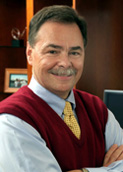 Fred Sanfilippo, MD, PhD |
Goals set the stage for success
One of the first things that impressed me when I joined Emory almost a year ago was the outstanding trajectory that the Woodruff Health Sciences Center (WHSC) has achieved over the past decade. The WHSC vision of “Transforming Health and Healing...Together” is clear and compelling, and significant progress continues toward its achievement. At WHSC leadership retreats held in October 2007 and March 2008 to accelerate our momentum, participants expressed a strong desire to clarify the goals that support our vision. In addition to providing the basis for prioritizing our activities, this clarification would also ensure that all faculty and staff were working toward the same outcomes. In response to this feedback, we launched a comprehensive process this past spring to clarify the goals of the WHSC. Using the existing goals and suggestions from the retreats, a preliminary set of three goals was drafted—and then the real work began. The drafts were presented to hundreds of faculty and staff members from every WHSC unit and department over the course of several months. Numerous questions and ideas were discussed around virtually every word, and this input was incorporated into each successive draft. By the June Board of Trustees meeting, we arrived at a set of three goals that had broad and enthusiastic support: We will transform health and healing together by being 1. the 21st century model for an academic health sciences and services center 2. an international leader in the highest quality patient care, research, education, and public service 3. a collaborative, inspirational environment that attracts and retains talented people. If you think these goals are lofty, you’re right. But that’s by design. I was continually impressed throughout this collaborative process by the high aspirations of our stakeholders. “Let’s aim higher,” they repeatedly said. “Why not shoot for more?” When we all work together toward these goals, the WHSC will almost certainly become the model academic health center in the country— the institution that others will try to emulate. By leveraging synergies among units, departments, schools, and interdisciplinary centers, and with our many local and national/international partners, we can excel in ways that few academic health centers can. We can enhance the quality of all that we do. And, of course, we can ensure that our success happens in a collaborative and inspirational environment. Together, we have the potential to improve lives not only here in Atlanta, but also across the country and the world. These over-arching goals will help us align our efforts, set our priorities, and establish benchmarks to measure progress toward our vision. In the coming months, you’ll hear a lot more about these goals and what they should mean to all of us. In the mean time, I hope you’ll begin to use them as guideposts as we continue transforming health and healing...together. Please share your thoughts and feedback at evphafeedback@emory.edu. |
|||
Goals set the stage for success Emory faculty in Republic of Georgia reported safe The person behind the planning Department hosts first research day Farewell to Edith Honeycutt
|
||||
|
Emory faculty in Georgia reported safe All Emory faculty and students have left the capital city of Tbilisi, Georgia, except medical faculty Kenneth Walker and Archil Undilashvili, who have reported to school officials that they are safe. Several Emory students working on a global nutrition program left Georgia before hostilities with Russia began. The medical dean's office continues to maintain close contact with Walker and Undilashvili. Walker currently is directing a grant from USAID, working with the ministry of health in Georgia to strengthen emergency medicine services; Undilashvili is the grant administrator. This grant involves the schools of medicine, public health, and nursing. Emory has long maintained partnerships with Tbilisi and Georgia aimed at improving education and health systems in Atlanta's sister city. In addition to including faculty and students from the three WHSC schools, the partnership under Walker's leadership has involved the Emory Global Health Institute, the WHSC Library, and collaborators from Morehouse School of Medicine, Georgia State University, and Georgia Tech. For background on some of the Emory work being done in Georgia, read more. |
|||
Bio stats: Contact: |
The person behind the planning
One in a series of profiles of people in the Woodruff Health Sciences Center Strategic planning almost always involves making hard choices, focusing on some agendas and postponing others. "It's challenging," says Shari Capers, "but it's exciting to watch groups agree on a set of goals and a plan that, once implemented, will benefit the communities we serve." As associate vice president for strategic planning, Capers heads an office that helps chart the course for both the WHSC and the university. Her group's job is to take collective energy, creativity, and vision from many people and coalesce plans that are cohesive, realistic, and filled with metrics to measure progress along the way. Examples of projects that Capers' team of 12 planners have worked on in recent months vary widely in size and scope, from helping prepare the presentation to trustees in June about the WHSC's five-year plan for clinical and research facilities to creating new centers of excellence and defining the strategic agenda for health care services for 2009. Each planning initiative is different, Capers says, but a few rules always apply. First, plans must reflect the WHSC’s overall priorities and link to the university-wide roadmap, which the planning team helped debut in 2005 to chart the university's goals and directions over the next 10 years. Second, plans must be based on realistic human, financial, and infrastructural resources. In the recent process leading to greater integration and expansion of the breast health center, for example, the planning office facilitated discussion across disciplines and helped spell out what different players would contribute and how they would work together to improve services for patients and families. Third, plans must incorporate ways of gauging progress. Balanced score cards are used to provide a tangible means of measuring progress toward achieving the goals. Capers began her career in health care as an emergency medicine nurse, a role in which planning for the unplanned is a constant priority. The experience helped her appreciate the benefits of applying planning principles over the long term, in settings where life-and-death choices, while less acute, are definitely still in play. "Things don't just happen," says Capers. "If you're trying to achieve positive transformation, planning will make the difference between actually doing so or not, whether you're trying to develop a new curriculum, integrate research and care, or establish a new service. If you plan well, people are more likely to benefit from the end result." Following her work in the ER, Capers earned a dual MBA/MHA (master of health administration). While working as a consultant for what was then KPMG, she was assigned to a project at the Emory Clinic, which in 1996 hired her away to work in its new strategic planning office. By 2001 when Capers was named AVP, strategic planning was a WHSC-wide function. Today the list of Capers’ bosses reflects how strategic planning is coordinated across Emory: She reports directly to EVPHA Fred Sanfilippo and works closely with the CEO of Emory Healthcare, each of the WHSC deans, the director of Yerkes, and the university provost. With the scope of work in strategic planning, there is little wonder that she has plenty of long days, but Capers uses her planning skills to find time to hang out with husband Rutledge and their daughter, two sons, and an “unabashedly lazy” golden retriever named Gracie. Capers also plays tennis, runs, hikes, camps, and maintains a flower garden that is very planned. |
|||
|
Department hosts first research day More than 100 faculty and postgraduate fellows from the medical school's Department of Medicine attended a daylong celebration of research earlier this summer. “It was the first,” says Kathy Griendling, vice chair for faculty development in the department, “but based on the enthusiastic response it certainly won’t be the last.” Along with Wayne Alexander (department chair), and Ken Brigham (vice chair for research), Griendling wanted to hold the event to give faculty, especially those early in their careers, an opportunity to find out what their colleagues were doing and to increase networking among researchers. Interested faculty submitted abstracts, which were reviewed by a committee of five senior faculty from the department. Ten researchers gave oral presentations, 10 minutes each. These, and the 54 poster presentations, included representatives from all of the department’s nine sections (cardiology, digestive diseases, endocrinology, general medicine, geriatrics, infectious diseases, nephrology, pulmonary, and rheumatology) and reflected the department’s dual emphasis on clinical and laboratory research. Some of the presenters already have been asked to speak in other forums, says Griendling, and others are planning collaboration on research projects. "That’s how it should work," says EVPHA Fred Sanfilippo, who gave the keynote address at the May 19 event. Much of his talk focused on the strategic advantages of collaboration across disciplines and its power to maximize funding, resources, infrastructure, personnel, fundraising, and scientific and career opportunities. Griendling says next year she plans to expand the program to include fellows, residents, and colleagues across the WHSC with whom departmental faculty work. |
|||
|
Emory students at the games
MD/PhD student Ken Sutha represented Georgia in the National Kidney Foundation Transplant Games, held last month in Pittsburgh, earning gold, silver, and bronze medals in the 50-yard breaststroke, 1,500-meter racewalk, and 100-yard backstroke, respectively. Diagnosed with kidney disease at age 10, Sutha received a kidney from his father in 2006 at Emory Hospital. The games represent the world's single largest gathering of transplant recipients (1,300), many of whom have had their transplants for 20+ years (some, 30 years). Sutha competes in the games to help draw attention to the need for donor organs. "I want people to know that transplants work. I'm doing well and leading a normal life. In fact I'm doing more now than I would otherwise." Sutha's research at Emory and Georgia Tech focuses on stem cells and bone regeneration. Read more. Another Emory student, Harris Patel, in the physicians assistant program, served on the 62-member medical staff at the Olympics in Beijing. His responsibilities included prepping US athletes for practice or competition, evaluating injuries, and helping implement treatment and rehab. "We have been on call 24/7 and on our feet for any medical emergency both on and off the field," says Patel. A certified athletic trainer, Patel interned with the US Olympic Committee medical staff in 2004 in Colorado Springs and was selected to go to the Youth World Championships in 2005. In 2006 he traveled to Birmingham, England, for a track and field meet and went to the 2007 Pan Am Games in Rio de Janeiro. Patel graduates in December and plans to work in primary care and sports medicine. Read more. |
|||
|
Noteworthy: new facilities, appointments, more • Guest house accommodates more pediatric patients A new $15 million, 50-bedroom Ronald McDonald guest house for pediatric patients and their families opened on Gatewood Road this summer near Emory-Children's Center and Children's Healthcare of Atlanta. The facility includes 10 isolation suites for children with weakened immune systems and replaces a previous house on Houston Mill Road that had 16 rooms. The new facility was built following a land swap between Ronald McDonald Charities and Emory. Two other facilities offering accommodations for patients and/or families include the Hope Lodge (cancer patients) and Mason Guest House (transplant patients), both on the Clairmont campus. • High-tech epilepsy unit incorporates canine visits Emory University Hospital has a new 10-bed epilepsy monitoring unit that allows for continuous video and EEG monitoring of brain activity to facilitate evaluation of seizures while they are occurring. Observation of seizures in real time facilitates diagnosis of seizure type and helps clinicians pinpoint location of onset, information that helps guide therapy. In addition to state-of-the-art technology, the unit partners with Canine Assistants to provide regular visits from trained service dogs, including seizure-response dogs, according to unit nurse director George Fraser. "Having these visits makes the environment more home-like and helps brighten a patient's stay," he says. Read more. • Dampier appointed medical director of clinical trials Sickle cell expert Carlton Dampier is the new medical director of the medical school's Office for Clinical Research. Before joining Emory, he was professor of pediatrics and associate chair for research at Drexel University College of Medicine and medical director of the Marian Anderson Sickle Cell Anemia Care and Research Center. He was director of clinical research, chief of hematology, and medical director of the Advanced Blood Conservation Program at St. Christopher's Hospital for Children in Philadelphia. An active clinical researcher, Dampier has been funded for more than 15 years by the National Heart, Lung, and Blood Institute for his studies of patient reported outcomes in children with sickle cell disease. He has served in numerous leadership positions in the National Sickle Cell Disease Program, including the NIH’s Comprehensive Sickle Cell Program and the Sickle Cell Disease Clinical Research Network, which he currently chairs. Read more. • Knechtle heads liver transplant program Surgeon Stuart Knechtle is the new director of liver transplantation. He comes to Emory from the University of Wisconsin at Madison, where he directed the liver transplant program there as well as clinical trials in transplant. He led a team that performed Wisconsin's first living-donor liver transplant and the state's first combined liver/pancreas transplant. His research in humans and nonhuman primates focuses on immune tolerance. In 1999, Knechtle founded Renovar, a biotech company specializing in diagnostic tests for kidney disease, and he remains chairman and chief scientific officer. Read more. • Yerkes earns continued accreditation Yerkes National Primate Research Center recently received continued full accreditation from the Association for Assessment and Accreditation of Laboratory Animal Care International (AAALAC) in a process including an extensive internal review followed by a site visit from AAALAC evaluators. Yerkes was first accredited in 1985 and must be re-evaluated at least every three years to remain accredited. This most recent evaluation was Yerkes' eighth straight subsequent site visit resulting in continued full accreditation. Read more. |
|||
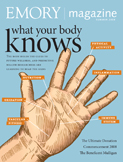 |
Clues to future wellness
Check out the most recent issue of Emory Magazine for a cover story on predictive health, which is authored by the magazine's editor, Paige Parvin, herself a "health participant" in Emory's new Center for Health Discovery and Well-Being. This issue also features an interview with EVPHA Fred Sanfilippo, a fascinating look at the medical school's body donor program, and a note about the extensive media coverage health policy expert Ken Thorpe (public health) has received for his role as architect of new health care systems in Vermont and West Virginia. |
|||
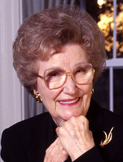 Edith Honeycutt Edith Honeycutt |
Honeycutt holds special place in Emory history
Emory lost a great friend last month with the death of Edith Honeycutt, 91. She entered nursing school here in 1936 and never really left. She served as private nurse to four generations of Woodruffs, starting with patriarch Ernest Woodruff, who engineered the takeover of The Coca-Cola Company from the Candler family in 1919. ("He liked for me to read to him the Lord's Prayer and the Coca-Cola stock prices from the newspaper," Honeycutt said.) She was also nurse to Ernest's son, legendary Coca-Cola leader and WHSC namesake Robert Woodruff and Robert's wife Nell, for whom the nursing school is named. A feisty and funny woman, Honeycutt was imaginative and resourceful in her efforts to raise money for the nursing school and other good causes, and she had a considerable following of fans and supporters. Two faculty chairs in nursing are named for her, and she received the Emory Medal in 1997. Read more. |
|||

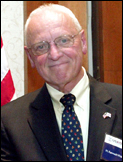 Kenneth Walker received an award in 2006 from USAID for his work in establishing the first pediatric emergency room in a pediatric hospital in any post-Soviet country.
Kenneth Walker received an award in 2006 from USAID for his work in establishing the first pediatric emergency room in a pediatric hospital in any post-Soviet country.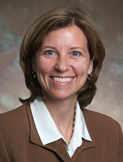 Shari Capers
Shari Capers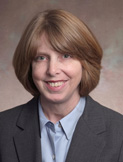 Kathy Griendling
Kathy Griendling Ken Sutha
Ken Sutha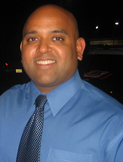 Harris Patel
Harris Patel Ronald McDonald house on Gatewood
Ronald McDonald house on Gatewood Epilepsy patient
Epilepsy patient 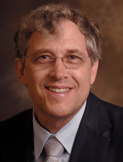 Carlton Dampier
Carlton Dampier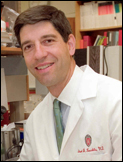 Stuart Knechtle
Stuart Knechtle